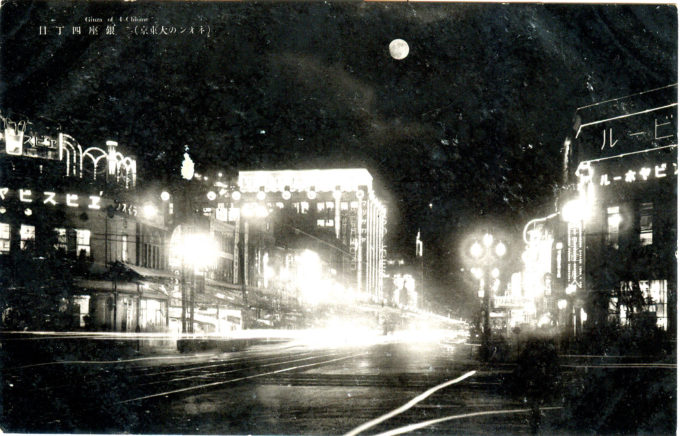“The Tokyo street scene is best at night, like a fashionable beauty. Electric light is cheap and competition is keen, and Ginza at night is more like foreign fireworks than a busy shopping street.
“By day its appearance rather suggests that some Japanese architects, after a rapid tour of Germany and Venice, had woke up on Coney Island and immediately started to draw elevations.
“… But at night, when the frenzies of the architects are lost in the soft, dark sky that always seem so close to the roofs, those fantastic patterns of neon are the lighting of what seems to the tourist a gorgeous stage filled with fay figures in fancy dress.”
– “The Soul of Tokyo”, by Hugh Byasi, Travel in Japan, Spring 1935

Ginza at night under a near-full moon, looking toward Ginza Crossing, c. 1935. At center, draped in neon, is Matsuzakaya department store. Ginza-dori is by flanked beer halls. To the left is Yebisu Beer Hall, one of the oldest beer halls in Tokyo (1899), and to its immediate right is Lion Beer Hall, with its gorgeous Art Deco and Gothic interior, that first opened in 1934.
See also:
Nippon Beer Hall, Ginza, c. 1950
“Historically, technologically-generated light made its presence felt on the landscape of everyday life in Tokyo, which had recovered from the [Great Kanto] earthquake, by the late 1920s. As the historian Gennifer Weisenfeld describes, ‘A flood of electric light transforms the street scene [of Ginza in the late 1920s] into an even more dramatic theatrical stage illuminated from above.’
“A popular song of 1932, ‘Flowering Tokyo’ (‘Hana no Tokyo’), which was the theme song of the film with the same title, attractively but critically captured the vision of Ginza at night as a brightly illuminated spectatorial space:
Yoru no Ginza wa hotaru kago
Koi no kokoro o chirachira to
Maneku hikari ni manekarete
Kite miru tsuki no hosoi koto
Ginza at night is a firefly cage
The flickering of love
Drawn by the inviting lights
I came and saw the moon; how thin it was.
– The Aesthetics of Shadow: Lighting and Japanese Cinema, by Daisuke Miyao, 2013

